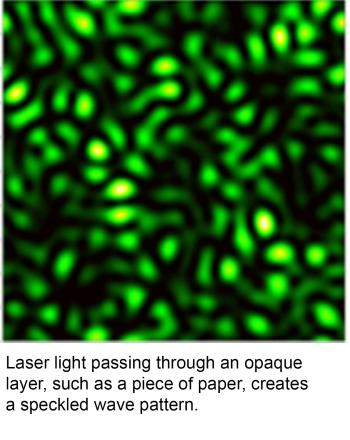NEW HAVEN, Conn., July 20, 2021 — Researchers at Yale University have developed a way to significantly increase the memory of speckle patterns, the very complex patterns that result from shining a laser light onto an opaque sheet, such as paper, biological tissue, or fog. The method has potential applications in biomedical imaging, optical metrology, and quantum information science.
Speckle patterns can be compared to what happens when many drops of water fall on the surface of a puddle at the same time, generating a wave pattern that quickly becomes very complex. Speckle patterns created from light have a certain memory, which researchers had previously used to develop a method for visualizing objects hidden behind an opaque layer.
The method involves passing light through an opaque layer (like a wall) to create a speckled light pattern behind the layer. While it gives the impression of being completely random, the pattern contains certain correlations resulting in an “angular memory”; tilting the incident laser beam on the opaque layer surface with a small angle yields the same transmitted speckle pattern, but with an angular tilt. The direction and angle of this tilt behind the opaque layer are the same as the tilt direction and angle at the input.
Senior author Hui Cao, the John C. Malone Professor of Applied Physics at Yale University, explained the concept. “Let us consider an example of pointing a laser pointer to a frosted glass window. A small amount of light will transmit through the frosted glass and produce a random grainy pattern on the other side of the window,” she said. “Now we point the laser at a slightly different angle to the frosted glass window, the transmitted pattern will remain more or less the same, but [tilted] by the same angle as the input beam. This is called the angular memory effect.
“Although the transmitted light pattern seems random, it ‘remembers’ the direction of incident beam; so if the direction of the incident beam changes, it will change accordingly.”

Laser light passing through an opaque layer, such as a piece of paper, creates a speckle wave pattern. Courtesy of the Yale School of Engineering & Applied Science.
When hypothetically replacing the laser with a projector showing a film, the image on the other side of the layer would be scrambled. When moving the projector, Cao explained, the pattern on the other side would move accordingly.
“People have previously used the angular memory effect to ‘see’ through the frosted glass window,” Cao told Photonics Media. “In the current example, it is possible to recover the picture from the scrambled images on the other side of the window using the angular memory effect.”
At the heart of the new method is the “transmission matrix” of the opaque layer, which gives the relationship between the laser light on the opaque surface and the laser light passing behind it. Using the experimentally determined transmission matrix, laser light on the surface is spatially shaped using a device known as a spatial light modulator. The spatially shaped light customizes the angular memory effect, allowing the transmitted speckle to behave as desired.
It was previously believed that the angular memory effect is a physical feature of the opaque material. By that thinking, the performance of the imaging methods using this memory effect would be limited by the physical properties of the material.
“In our study, though, we have shown that this view is much too pessimistic,” said lead author Hasan Yilmaz, assistant professor at Bilkent University, UNAM. “The angular memory of the lightwaves passing through the opaque layer can be modified independently of the physical properties of the opaque material, by controlling the shape of the incident light.”
“This work will impact not only imaging through opaque media, but also through multimode optical fibers with potential applications in endoscopy and remote sensing,” Cao said. "A long multimode optical fiber does not possess the conventional angular memory effect, but using our method, it is possible to introduce any desired memory for light transmitted through a multimode fiber by modulating the incident wavefront of a laser beam. Although our current experiment was conducted with classical light, our new method is applicable to customize the angular memory effect for quantum waves. One application might be quantum communication through turbulent media such as the atmosphere.”
The research was published in Physical Review X (www.doi.org/10.1103/PhysRevX.11.031010).